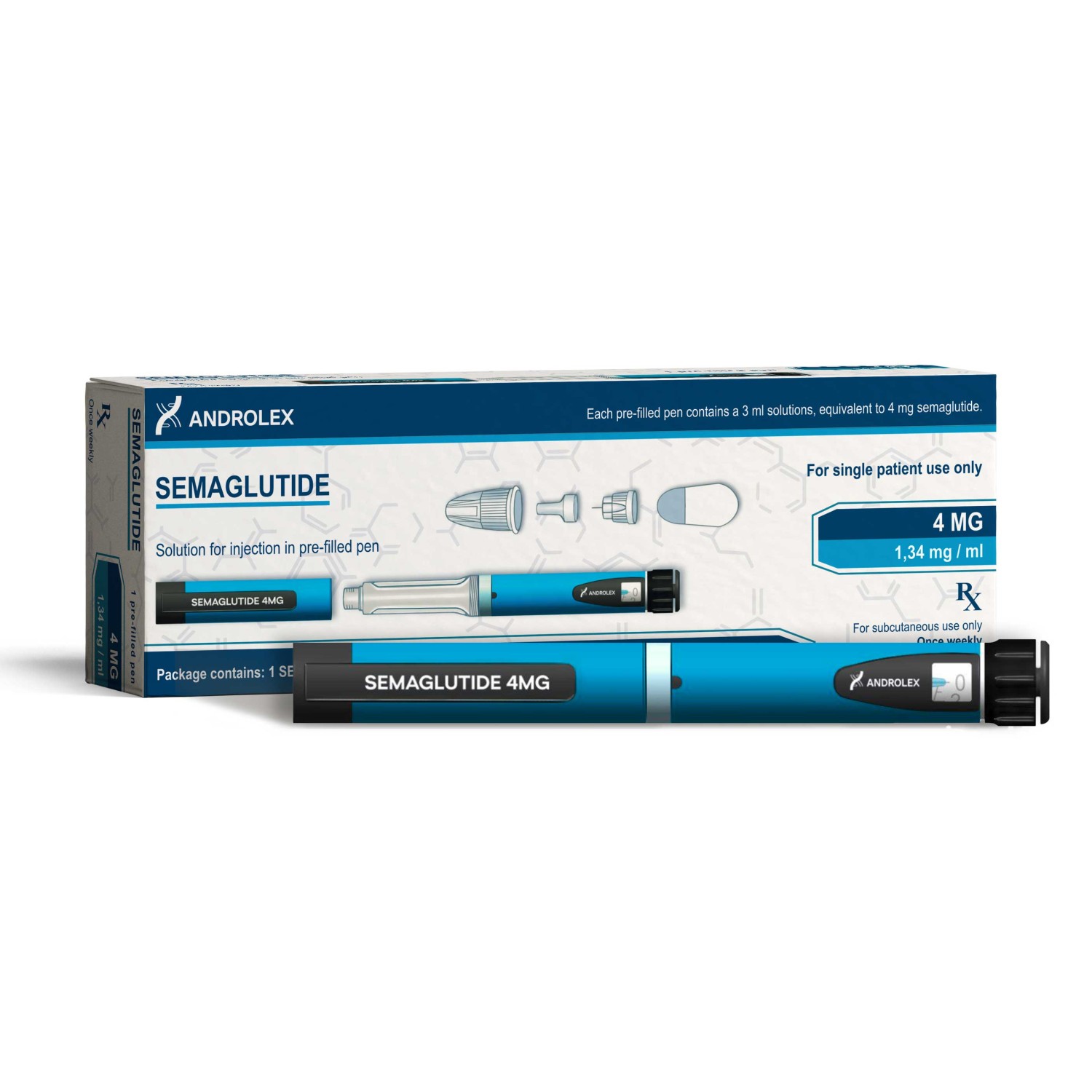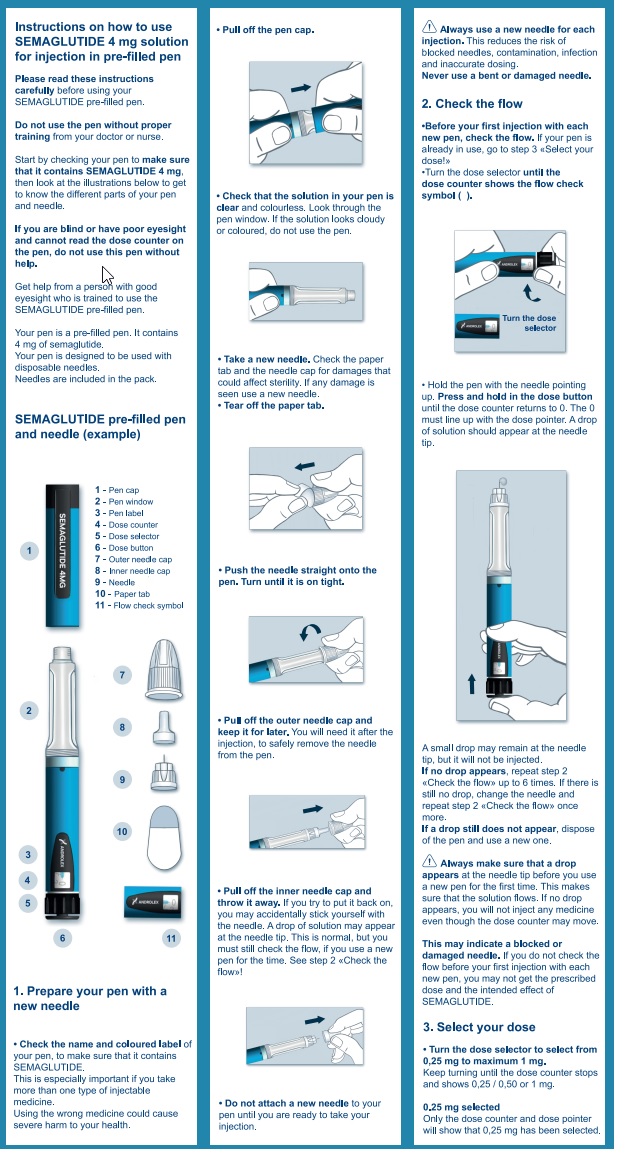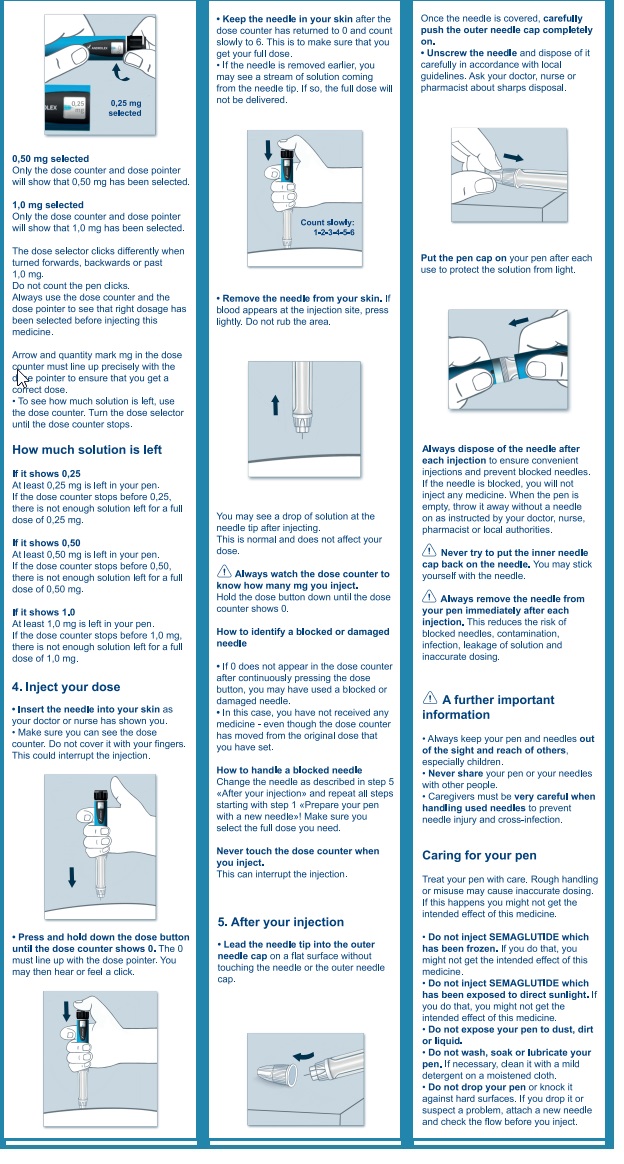



- Stock: In Stock
- Package: 4mg
Understanding Semaglutide
Semaglutide is a well-known medication used primarily to treat type 2 diabetes. It's classified as a “GLP-1 receptor agonist”.
Aside from diabetes, it's also prescribed for weight control in people with specific health conditions since it aids in regulating blood sugar and notably in suppressing hunger, which can help with weight reduction.
The Advantages of the Pen Form
The pen form of Semaglutide provides user-friendliness, accurate dosage, and is easy to carry around. Reasons it stands out include:
- User-Friendly: The design of the pen allows for individuals to give themselves the injection, bypassing the need for professional assistance. It's crafted to be straightforward to hold and utilize, especially compared to traditional injection strategies.
- Dose Accuracy: It allows users to choose precise dosages, ensuring that the medicine's amount is correct each time, thus minimizing chances of mistakes in dosage.
- Handiness: Being prefilled and disposable, this pen is compact and subtle for ease of transportation and use, anytime and anywhere.
- Minimizing Injection Worry: Its design, typically concealing the needle, can lessen the discomfort and worry associated with injections.
- Treatment Consistency: Because it's straightforward and discrete, people might be more committed to their medication schedule, which can improve disease management.
In essence, the pen makes delivery of the medication convenient and more pleasant for people with type 2 diabetes or other conditions necessitating injected treatment.
How it Works
Semaglutide mimics the GLP-1 hormone to lower high blood sugar in several ways, such as boosting insulin when blood sugar is high and slowing down sugar production in the liver, which helps manage how much you eat and reduces overall calorie intake.
Semaglutide Advantages
For those dealing with type 2 diabetes or wanting to manage their weight, Semaglutide has many benefits:
- Better Blood Sugar Management - By promoting insulin production as needed, it brings down sugar levels in the blood;
- Weight Reduction - There is evidence that it cuts down the risk of serious heart problems like heart attacks and strokes;
- Heart Health - Some studies have shown it may lower the risk of major heart events, potentially saving lives;
- Simplified Dosage - With weekly injection schedules, it's more convenient than medications taken daily;
- Lower Hypoglycemia Risk - It tends to cause less low blood sugar levels compared to other diabetes treatments when taken on its own.
The Role of SEMAGLUTIDE
Semaglutide is the active agent in this medication, which helps lower blood sugar levels and may also contribute to heart disease prevention.
The use of SEMAGLUTIDE:
- Alone – for those whose blood sugar isn't well-managed by diet and exercise and who can't take metformin;
- Combined – with other diabetes drugs when more control over blood sugar is needed. It's essential to keep following the diet and exercise regimen as recommended by your healthcare provider.
Possible Side Effects of Semaglutide
Semaglutide might lead to certain side effects, like:
- Nausea
- Upset stomach
- Digestion issues
- Loose stools
- Stomachache
- Irregular bowel movements
- Headaches
- Tiredness
- Decreased hunger
Rare but serious issues may include inflammation of the pancreas, kidney complications, and a heightened chance of specific thyroid cancers. It's critical to talk about these potential risks with your physician.
Usage Guidelines for Semaglutide
The medication's dose is adjusted based on how the patient reacts and tolerates it, with a once-weekly subcutaneous injection. Here's the typical cycle for dosing Semaglutide:
- Initial Dose: To start, 0.25 mg once weekly for a month is advised. This dose is more about getting your body used to the medication rather than controlling blood sugar.
- Continuing Dose: The dose may be raised to 0.5 mg weekly after four weeks. The amount might be adjusted based on patient needs and medication tolerance.
- Ramping Up: For greater blood sugar management, the dose may be upped to 1 mg per week after a month — and potentially even doubled eventually, provided it's well tolerated.
Administration of SEMAGLUTIDE
SEMAGLUTIDE is intended for subcutaneous injections. Avoid injecting into veins or muscles.
- It's best to administer the injection in your thigh, abdomen area, or upper arm.
When to Use SEMAGLUTIDE
- It should be taken weekly on the same day if possible.
- The exact timing isn't crucial – you can inject it with or without food.
Precautions for Use
- Pancreatitis: There have been some reports of this condition with drugs like Semaglutide. If you exhibit symptoms, stop taking the drug and get medical advice.
- For those with diabetic eye disease, take caution as it may exacerbate the condition.
- Kidney Problems: There’s a risk of acute and worsening kidney issues, potentially needing dialysis treatment.
- When combined with specific diabetes medications, there's an increased risk of gallbladder problems, such as gallstones.
- If you're also taking insulin, be aware that Semaglutide may raise the risk of low blood sugar levels. Discuss with your healthcare provider about potentially lowering your insulin dose.
Storing SEMAGLUTIDE Properly
Keep it where children can't find or reach it and check expiration dates before use—store unused pens in the fridge but not too close to the cooler and shielded from light.
Before Using:
Keep it cool before opening and don't let it freeze.
While Using:
- Store it under 30 °C or in the fridge, away from the cooler, and don't use it if frozen.
- To protect from light when not using it, keep the cap on.
- Don't dispose of the medicine carelessly – ask a pharmacist for environment-friendly disposal methods.
Package Contents and Other Details
What's in SEMAGLUTIDE
- The main ingredient is semaglutide. You get 1,34 mg in every milliliter of the injection. Each pen comes with 4 mg in 3 ml of the solution. The doses vary from 0,25 to 1 mg of semaglutide in 0,74 ml of solvent.
- Apart from semaglutide, it also has: disodium phosphate dihydrate, propylene glycol, phenol, sterile water, and agents to maintain pH balance. For more details on sodium, see another section.
Appearance and Pack Details
- Semaglutide comes as a clear solution ready to use in a pen injector, with 3 ml in each.
- The 4 mg dosage is sold in kits featuring:
- One pen along with four needles for one-time use.
- Guidance on using the 4 mg Semaglutide injection with the pre-filled pen is provided.
- Your injector pen comes pre-loaded with 4 mg of Semaglutide.
- It's meant for single-use needles, which come with the kit.
Purchasing Semaglutide
Currently, it's hard to find this medicine in physical pharmacies, leading to an uptick in online purchasing. It's usually provided only with a prescription for diabetes patients.
Reasons to Consider Buying It
Semaglutide could be your answer if you're combating constant hunger on your weight loss journey. Regarded as both safe and beneficial, it assists in reducing appetite, shedding weight, getting rid of fat, and potentially even steering clear of diabetes.
Frequently Asked Questions
Handling an Overdose
Given the packaging, unintended high doses are unlikely. However, should it occur, significant low blood sugar and severe health consequences are possible. If you have taken too much, get medical help right away.
Legality of Online Purchases
Buying Semaglutide via the internet isn't illegal, but be mindful of prescription rules in your country. Avoid dubious large purchases by post.
Can It Help With Weight Loss?
Indeed, it's used for losing weight in people with type 2 diabetes and even for those without diabetes who want to manage their weight because of its hunger-reducing properties.
It's scored popularity with celebrities and those looking for a straightforward weight loss solution.
Is It the Same as Insulin?
While some might confuse Semaglutide with insulin, they're not the same. It is a GLP-1 receptor agonist that helps lower sugar in the blood and supports weight loss, different from insulin which can increase fat storage.










